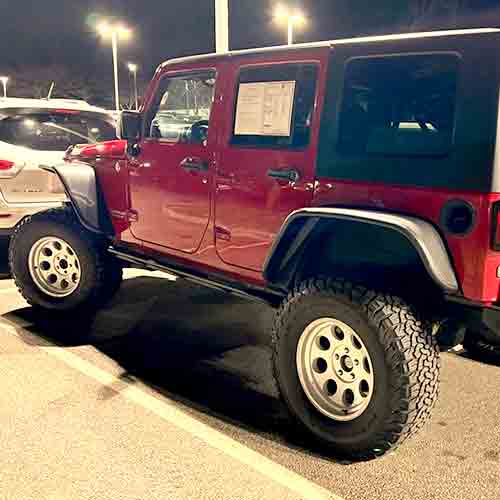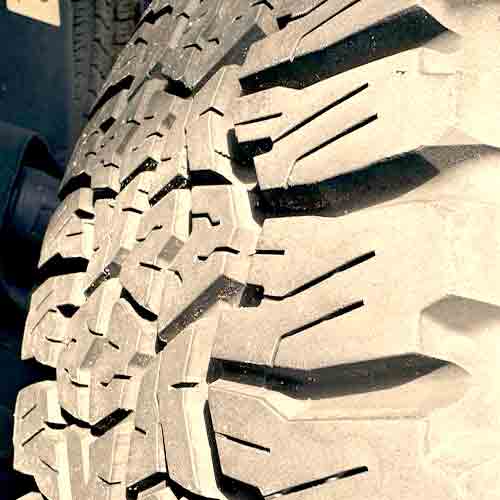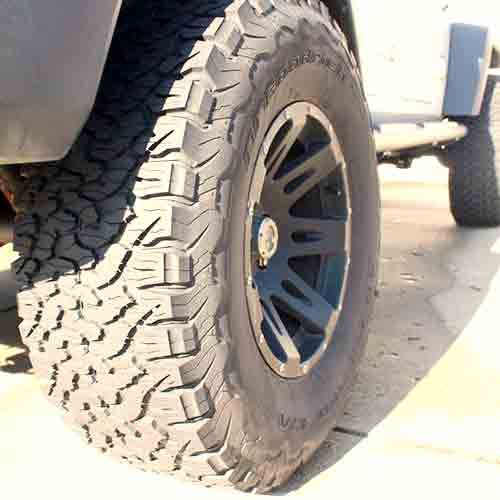Goodyear Wrangler Ultraterrain AT and the BF Goodrich KO2 being powerful all-terrain tires allow you to tackle a lot of different kinds of terrains including smooth highways. Though there are key factors to consider on both. Let’s find them out.

As an experienced tire engineer, I can tell you that the BF Goodrich KO2 is a better tire, when it comes to dry on-road performance, noise, tread life, and off-road traction (with it’s superb durability). The Goodyear Wrangler UltraTerrain, on the other side, does better on wet roads, has superior ride quality, and yields a better winter traction in comparison.
Must Know Facts
BF Goodrich KO2 features 90 sizes in 15 to 22 inches. These sizes come with following.
- Speed Ratings: R, S, or Q
- Load ratings: C to E
- Weight range: 35 lbs to 67 lbs
- Tread Depth: 15/32″ on all sizes
- Winter ratings: M+S and 3PMSF
- Warranty: 50k miles
Review this tire here: https://tiredriver.com/bf-goodrich-ko2-review/
Goodyear Wrangler UltraTerrain AT has limited sizes in 16 to 20 inches rims, with following specs.
- Speed Ratings: S and Q
- Load Ratings: SL and E
- Weight Range: 40 to 70 lbs
- Tread Depth: Either 16/32″ or 18/32″
- 3PMSF and M+S ratings available
- Doesn’t offer any treadwear warranty
Learn all about load ratings: https://tiredriver.com/load-index-range-and-ply-rating/
Outer Construction
Starting with Goodyear UltraTerrain.

So this tire features very aggressive biters in the middle.
There are basically 2 ribs there, featuring somewhat triangularly shaped lugs divided up with grooves. So these grooves/tread voids creates a web of channels which connect the outer wider circumferential ones, separating the shoulders.
They carry full depth sipes, have off-set edges and their haphazard placement provide ample bite off-road.
In comparison the shoulder lugs are slightly bigger, though they don’t get to have as many biters, though they have notches facing the middle and (slightly different) rectilinear sipes.
They also have sharp edges, as each block is serrated on itself.
On the other side, you get a slightly more combative design with BFG KO2.

This tire shows up with 3 lugs in the middle forming an interconnected web of grooves.
With a consistent and uniform pattern, these lugs get to provide ample grip on dry roads, where off-roads, as these lugs are equipped with full depth notches and sipes, they split open the blocks where needed, providing great grabbing/chewing capabilities.
Moving towards the shoulders, the tire gets to be even more wild.
Here the tire features very weird looking shoulder lugs with full depth slanted notches.
They also form a very aggressive gaps in between where bold stone ejectors are placed.
Actually the tire makes two types of these ejectors, where the triangularly shaped ones are place in the outer circumferential grooves, while the conventional ones are seen in between these shoulders.
Furthermore, these lugs have full depth notches and similar (to the middle) siping pattern. And these combined with outer edges, you get a superior biting effect.
Basically towards outer edges, you get very thick mud scoops with staggered shoulders, and as both lugs are joined up together on the sidewalls (forming chunky lugs there), they offer tremendous grip on all types of rugged terrains (especially when you lower the air pressure to lower PSI values).
Internal Construction
All-terrain tires are made tough through their internal construction and the composition of the rubber on the tread. In terms of composition, both tires get to have a cut resistant rubber and good enough tread depth (supplying thicker rubber skin).
Though internally, the BF Goodrich KO2 gets to have an upper hand.
As it features 3 ply polyester cover, with 2 steel belts and 2 nylon cap plies, which are also spirally wound, adding to the toughness further.
The Goodyear Wrangler UltraTerrain AT on the other side, only offer 2 ply sidewalls.
For Your Info: In my list of top all-terrain tires, the BFG KO2 is ranked for it’s epic durability. Check the list here: https://tiredriver.com/bf-goodrich-ko2-review/
Traction on Highways
Off road tires compromise a little on streets, even when things are dry, as they lack in giving better steering feedback as well as directional and lateral traction.
Longitudinal Grip
The longitudinal/directional grip depends on how much the middle area of the tire’s tread meet with the road, and considering this (and some other factors like the weight and tire’s composition, and tread depth), its understandable why the BF Goodrich KO2 dilivers a better traction value overall.
The Goodyear UltraTerrain A/T basically gets to make thinner lugs, surrounded with larger tread voids and so they don’t yield as good of a contact patch to meet up with the road, like the KO2.
Lateral Grip
Lateral traction, or the tire’s ability to corner, is largely determined by the shoulder lugs, as they bear the majority of the (vehicle’s) weight during turns, and they need to have a strong bond with the road to maintain traction.
That’s why BF Goodrich KO2 having such aggressive shoulder design, prorates limited lateral g forces, in comparison (which is another measure of lateral traction, besides calculating average handling times on laps).
The Goodyear UltraTerrain A/T on the other hand provides more on-road minded shoulder blocks, which sidewise sipes, and less aggressive notches, which don’t eat away as much rubber.
Steering Sensitivity
BFG KO2 features a dual compound, with doughier rubber layer on top, and a harder composition underneath. This furnishes it’s lugs with foundational supports, so they don’t flex around too much.
Though, it’s steering response is still not necessarily better, in comparison.
That’s because, the Goodyear Wrangler UltraTerrain A/T may have a larger tread depth and a softer compound to its disadvantage, but it’s shoulder lugs are still more stuffed up together, and are also reinforced with secondary layers running underneath.
So subjectively, it gives out a similar under and over-steering balance and steering feedback.
Recommended Read –
Are A/T tires worth it: https://tiredriver.com/are-all-terrain-tires-worth-it/
Wet Performance
Wet performance is divided into two aspects: wet traction and hydroplaning resistance. Out of them, although grip is slightly difficult to achieve, A/T tires do good with hydroplaning. Let’s discuss them both.
Wet Grip
To maximize wet road grip, the tire must be equipped with 2 things, sipes, and flexibility.
And so with stiffer compound, the BFG KO2 does not allow it’s lugs to bend too much, so even though you get a lot of siping on this tire, they are not so effective overall.
Ironically, it’s sipes do better on dry roads, as they get to flex much better there, opening/closing, to bite in to the surface.
On wet roads, they are just to stiff to flex as much and suck water particles in.
In comparison, the Goodyear Wrangler UltraTerrain AT provides better efficacy, even though you get less overall siping.
Hydroplaning
The occurrence of aquaplaning, or hydroplaning, happens when a tire struggles to remove water from its tread quickly, causing it to float, shrinking traction.
This forms a layer of water between the tread and the road, and the tire loses all grip.
Though as both tires are bald enough, they provide ample grooves to clear water off quickly, resisting to hydroplaning.
Off Road Performance
The off-road environment can be tough, with terrains including mud, and sharp rocks there are some where A/T tires can navigate much easily.
Let me discuss thees all separately.
On Mud
“Mud is all terrain tires biggest enemy”, but even wondered why is that?
Well, this is because these tires still don’t provide enough tread voids for the thick mud to easily pass through. So although you can take these tires on lighter terrains, for deeper muddy tracks, you need mud-terrain tires.
Having said that, out of both tires, you see a better traction on KO2. This is because the tire offers greater escaping of the mud, and at the same time provide you with the paddling capabilities.
The Goodyear UltraTerrain A/T has longitudinally adjusted lugs, restricting thick mud to leave out of the tire laterally, and it’s mud scoops are also not as thick as seen on KO2, which paddle the mud backwards and generate forward moving force as a result.
For Your Info: Out of all tire’s I’ve reviewed, the Goodyear Wrangler Duratrac (review) provides the best mud traction.
Rock Climbing
On rocky terrains, you need a flexible biting tread which can grip in multiple directions, especially laterally. This is because with sideways slippage, a tire can get overturned (during climbing)
Moreover, you also need a lot of durability, (trust me, saying form experience).
And coming in with both of these features, the BF Goodrich KO2 is a better tire to have here. Its 3 ply polyester construction makes it a lot more tougher and it’s hook shaped design provide a better grip in all directions.
Desert Traction
To drive on sand with ease, tire air pressure must be reduced, as this leads to floating. And helping to that, are tire’s weight (being light), softer compound (which can meet better with the sand), and sidewall lugs (which can provide extra contact patch).
That’s why out of both tires, the BF Goodrich KO2 does better overall.
The Goodyear UltraTerrain is more biting towards the edges, and its sharp sidewall lugs are also not helping, where on KO2 they paste/spread out on a larger scale providing more rubber to sand contact and with it, floating abilities.
On Gravel and Dirt
With missing stone ejectors the Goodyear UltraTerrain isn’t able to provide as much traction as the KO2, where you see dual stone ejectors.
In fact, the Ko2 is one of the best when it comes to dirt filled roads, as the tire learned a lot form its predecessor.
The previous design, “KO” basically had a tread which would easily invite in the sharp stones and rocks, that would cause damage, and traction problems.
But with BFG KO2, the triangular stone ejectors on the outer circumferential grooves, and conventional ones between shoulder voids provide ample debris cleaning abilities, which are hard to compete with.
Fuel Economy
A heavier tire would consume more fuel, as it would take up more energy to be carried around, it’s not rocket science. Though still there’s flexing of the lugs as well, which is a little more difficult to understand.
When a tire corners, brakes or accelerates, the tread blocks bend in the opposite direction of the applies force. This causes energy to get consumed in to bending of these blocks instead of rolling the tire.
That’s why Goodyear Wrangler UltraTerrain AT with a softer compound and larger tread depth consumes more fuel in comparison.
Tread Wear
There are two things that causes tread wear, tire’s weight, and tread composition. Though since tread wear has two further dimensions, the wearing time, and the wearing rate. It can be explained why the BF Goodrich KO2 provides you with a greater mileage.
The Goodyear UltraTerrain on the other hand, puts more pressure on it’s lugs with its slightly heavier weight, and they rub off the ground with greater friction, where the softer compound is not helping either.
Though the larger tread depth do allow this tire to still have a decent wearing time, (before it reaches to 2/32″ of legal limit). But still it’s not as great as the KO2.
Ride Quality
Ride comfort is very important for all-terrain tires, in fact, it’s the main reason why these tires exist. They cater off-road traction only after ensuring they are good enough comfort-wise on-roads, first.
And here the Goodyear UltraTerrain is very impressive.
The tire deals with noise in a better way, with it’s whisper grooves, and superior pitch sequencing, and it’s softer compound provides better cushioning to the bumps.
For Your Info: Whisper grooves, are simply connectors between the shoulder blocks, and they don’t allow the air particles to come in and hit around the tread walls (which generates noise), and the little bit of air that does come in, is handled by varying the geometry of the lugs, they engage different “pitches” and tones, which then (try to) cancel out each others’ amplitudes.
Winter Performance
Both tires are 3 peak mountain snowflake rated, though still, overall, you get a better hard-packed snow performance on Goodyear Wrangler UltraTerrain AT as the tire is pretty optimized for it.
But how it that?
Well, because it carries a lot of features mostly seen on winter tires. It’s tread width is narrower (on average), it’s weight is heavier, and it’s features a lot of notches and in-groove biters.
All of them help in grabbing the snow particles and sticking them inside the grooves, and these make snow to snow contact (which yields better friction compared to a rubber to snow contact).
The BF Goodrich KO2 on the other hand, is although also great with it’s “meshed” structure providing similar effect, it’s harder compound is more susceptible to getting frozen up, so it’s biters don’t supply better gripping capabilities.
Recommended Read –
Are A/T tires good in Snow: https://tiredriver.com/are-all-terrain-tires-good-in-snow/
Conclusion
Out of both tires, the BFG KO2 is a tougher tire bringing improved off-road traction to the table, may it be mud, rocks, sand, you name it. Though it does that by ensuring the highway grip stays in tact (but that only goes for dry roads).
The Wrangler UltraTerrain on the other side, renders a better wet gripping design, providing amazing resistance to hydroplaning. The tire is also very fuel efficient, and comfortable as well, but could use a little more tread life.
I have had multiple sets (7-8 total) of The BFG AT on multiple 2500 series trucks. I have never lost even one to a nail or road hazard. But if you don’t rotate them every 4000-5000 miles they get noisey. The are expensive but you will get Flawless performance for their 50,000 mile life
Thanks for sharing Jim.